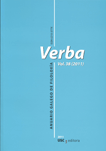Dixon, R. M. W. (2016): Are some languages better than others? New York: Oxford University Press, vii + 272 págs.
Contenido principal del artículo
Detalles del artículo
Referencias
Bickerton, D. (1995): Language and Human Behavior. Seattle: University of Washington Press.
Chesterman, A. (2016): Memes of Translation. The Spread of Ideas in Translation Theory. Revised ed. Amsterdam: John Benjamins. https://doi.org/10.1075/btl.123
Chomsky, N. (2000): “Minimalist inquiries: the framework”, en R. Martin, D. Michaels & J. Uriagereka (eds.): Step by step. Essays on minimalist syntax in honor of Howard Lasnik. Cambridge MA: MIT Press, pp. 89-155. Hay trad. de V.M. Longa, “Indagaciones minimalistas: el marco”. Moenia 5, 1999, pp. 69-126.
Crystal, D. (2010): The Cambridge Encyclopedia of Language. 3rd ed. New York: Cambridge University Press.
Dennett, D. C. (1995): Darwin’s Dangerous Idea. New York: Simon & Schuster.
Deutscher, G. (2009): “’Overall complexity: A wild goose chase?”, en G. Sampson, D. Gil & P. Trudgill (eds.):Language Complexity as an Evolving Variable. New York: Oxford University Press, pp. 243-251.
Everett, D. L. (2005): “Cultural constraints on grammar and cognition in Pirahã. Another look at the design features of human language”, Current Anthropology 46/4, pp. 621-634. https://doi.org/10.1086/431525
François, F. (1969): “Redondance”, en A. Martinet (dir.): La Linguistique. Guide alphabétique. Paris: Debóel, pp. 330-335. Cito por la trad. de C. Manzano, “Redundancia”, en La Lingüística. Guía alfabética. Barcelona: Anagrama, 1972, pp. 338-343.
Gil, D. (2008): “How complex are isolating languages?”, en M. Miestamo, K. Sinnemäki & F. Karlsson (eds.) (2008):Language Complexity. Typology, Contact, Change. Amsterdam: John Benjamins, pp. 109-131. https://doi.org/10.1075/slcs.94.08gil
Gil, D. (2009): “How much grammar does it take to sail a boat?”, en G. Sampson, D. Gil & P. Trudgill (eds.) (2009):Language Complexity as an Evolving Variable. New York: Oxford University Press, pp. 19-33.
Hockett, Ch. F. (1958): A Course in Modern Linguistics. New York: MacMillan. Cito por la trad. de E. Gregores & J. A. Suárez, Curso de lingüística moderna. Buenos Aires: Eudeba, 1971.
Karlsson, F., M. Miestamo & K. Sinnemäki (2008): “Introduction. The problem of language complexity”, en M. Miestamo, K. Sinnemäki & F. Karlsson (eds.): Language Complexity. Typology, Contact, Change. Amsterdam: John Benjamins, pp. vii-xiv. https://doi.org/10.1075/slcs.94.01kar
Kortmann, B. & B. Szmrecsanyi (eds.) (2012): Linguistic Complexity: Second Language Acquisition, Indigenization, Contact. Berlin: De Gruyter. https://doi.org/10.1515/9783110229226
Kusters, W. (2003): Linguistic Complexity: The Influence of Social Change on Verbal Inflection. Utrecht: LOT.
Martinet, A. (1962): A Functional View of Language. Oxford: Claredon Press. Cito por la trad. de Mª. R. Lafuente, El lenguaje desde el punto de vista funcional. Madrid: Gredos, 1971.
McWhorter, J. (2001): “The world’s simplest grammars are creole grammars”, Linguistic Typology 6, pp. 125-166. https://doi.org/10.1515/lity.2001.001
Miestamo, M. (2008): “Grammatical complexity in a cross-linguistic perspective”, en M. Miestamo, K. Sinnemäki & F. Karlsson (eds.) (2008): Language Complexity. Typology, Contact, Change. Amsterdam: John Benjamins, pp. 23-41. https://doi.org/10.1075/slcs.94.04mie
Miestamo, M., K. Sinnemäki & F. Karlsson (eds.) (2008): Language Complexity. Typology, Contact, Change. Amsterdam: John Benjamins. https://doi.org/10.1075/slcs.94
Moreno Cabrera, J. C. (2000): La dignidad e igualdad de las lenguas. Crítica de la discriminación lingüística. Madrid: Alianza Editorial.
Piantadosi, S. T., L. Stearns, D. L. Everett & E. Gibson (2012): “A corpus analysis of Pirahã grammar: An investigation of recursion”. Comunicación presentada en el 2012 LSA Annual Meeting, Portland. Disponible en: https://tedlab.mit.edu/tedlab_website/researchpapers/Piantadosi_et_al_2012_LSAtalk_Piraha.pdf.
Riddle, E. M. (2008): “Complexity in isolating languages: Lexical elaboration versus grammatical economy”, en M. Miestamo, K. Sinnemäki & F. Karlsson (eds.) (2008): Language Complexity. Typology, Contact, Change. Amsterdam: John Benjamins, pp. 133-151. https://doi.org/10.1075/slcs.94.09rid
Sampson, G. (2009): “A linguistic axiom challenged”, en G. Sampson, D. Gil & P. Trudgill (eds.) (2009): Language Complexity as an Evolving Variable. New York: Oxford University Press, pp. 1-18.
Sampson, G., D. Gil & P. Trudgill (eds.) (2009): Language Complexity as an Evolving Variable. New York: Oxford University Press.
Trudgill, P. (1983): On Dialect. Social and Geographical Perspectives. Oxford: Basil Blackwell.
Artículos más leídos del mismo autor/a(s)
- Antonio Benítez-Burraco, Víctor M. Longa, Los peligros de la interpretación de las evidencias indirectas sobre la evolución del lenguaje: dextralidad y capacidad lingüística de los Neandertales , Moenia: Vol. 17 (2011)
- Victor M. Longa, J.J. López Rivera, Bibliografía seleccionada y comentada sobre la metáfora , Moenia: Vol. 17 (2011)
- Víctor M. Longa, Cuando el traductor es demasiado visible: reescritura y manipulación en la traducción del título de un libro , Verba: Anuario Galego de Filoloxía: Vol. 39 (2012)
- Victor M. Longa, Reseña de Robert C. Berwick y Noam Chomsky (2016): Why only us. Language and evolution. Cambridge, MA: The MIT Press, viii + 215 pp. , Verba: Anuario Galego de Filoloxía: Vol. 44 (2017)
- Victor M. Longa, Caroline Myrick & Walt Wolfram (eds.): The 5 Minute Linguist. Bite-Sized Essays on Language and Languages, 3rd ed. Sheffield: Equinox Publishing, 2019, XVI + 345pp. ISBN: 978-178-179-855-3 , Moenia: Vol. 27 (2021)







